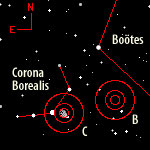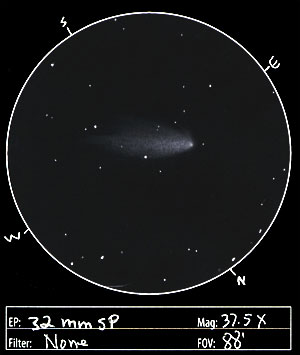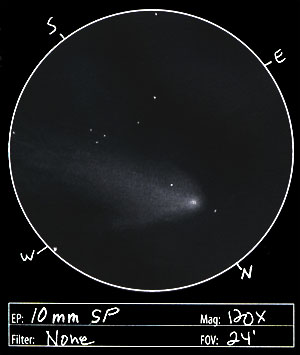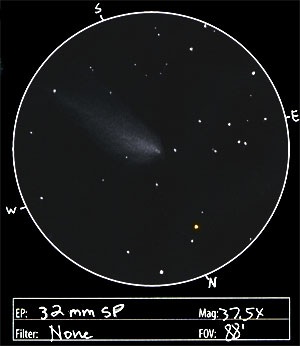Move mouse over upper image for labels.
Observation Notes
 I finally got a chance to view this comet from a dark site. It almost seems unfair to compare this observation to what I saw from home. It was a real beauty. In addition to the darkness, time and averted vision worked wonders for both fragments B and C. High clouds were threatening, but the region of Corona Borealis stayed clear.
I finally got a chance to view this comet from a dark site. It almost seems unfair to compare this observation to what I saw from home. It was a real beauty. In addition to the darkness, time and averted vision worked wonders for both fragments B and C. High clouds were threatening, but the region of Corona Borealis stayed clear.
The nucleus of the C fragment was stellar, and the bulk of the tail stretched about 25' southwest. There were multiple spokes visible in the tail, with the northwest edge being the brightest. The 120X view showed two of the brighter spokes much better. Over the course of 80 minutes, the 120X view showed about 3' of motion to the northeast, or about 2.25' per hour. My planetarium software gives a rate of 2.5' per hour. Bluring the view gave a brightness similar to a star about half degree north of the cometâ€"SAO 83848â€"which is magnitude 8.53.
The B component was easily visible, with a length comparable to the C componentâ€"about 25' long. It was fainter, a bit wider, and lacking a strong pseudonucleus. It also suggested some spokes in its tail with the northwest side being brighter. Viewing at 120X revealed the nuclear region to be elongated northeast to southwest with a couple soft clumps hinted at. A bright orange star marked the north side of the view.
I was getting mighty cold as the wind picked up so I was in a hurry to pack up. As I was doing this, an owl started hooting over and over again. It reminded me that there might be predators roaming around. I guess it goes without saying that I'd really hate to have a mountain lion pounce on me in the inky darkness. Another observer has noted that he's had the hair stand up on the back of his neck at this site as well.
Factoids
| Subject | 73P/Schwassmann-Wachmann 3 - Components B and C | |
| Classification | Comet | |
| Position* | Boötes and Corona Borealis Component C APR 20, 2006 05:15 UT - [RA: 15:29:36 / Dec: +26:34:02] APR 20, 2006 06:55 UT - [RA: 15:29:53 / Dec: +26:36:01] Component B APR 20, 2006 06:30 UT - [RA: 15:07:47 / Dec: +28:09:02] | |
| Size | Component C: Tail: 25' Component B: Tail: 25' | |
| Brightness* | Component C: ~8.5 Component B: ~9 | |
| Date/Time | April 19, 2006 - 10:15 - April 20, 2006 - 12:00 AM MST (April 20, 2006 - 05:15 - 07:00 UT) | |
| Observing Loc. | Cinder Hills Overlook, Sunset Crater National Monument, AZ | |
| Instrument | Orion SVP 6LT Reflector (150 mm dia./1200 mm F/L) | |
| Eyepieces/Mag. | 32 mm, 25 mm, and 10 mm Sirius Plössl (37.5X, 48X, 120X), and 10 mm Sirius Plössl + 2X Barlow (240X) | |
| Conditions | Partly Cloudy, Breezy, 38°F | |
| Seeing | 5/10 Pickering | |
| Transparency | Mag 6.2 NELM | |
| *Sources | Orion's The Sky Software;Aerith.net |







